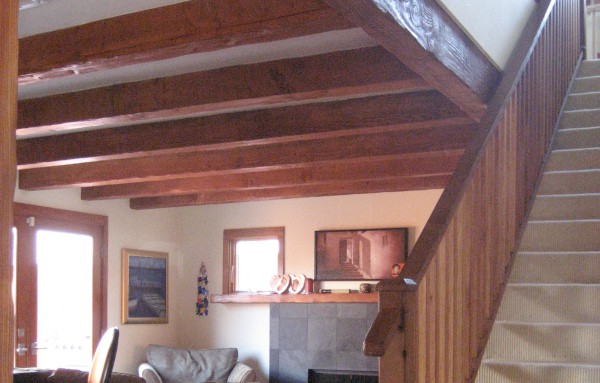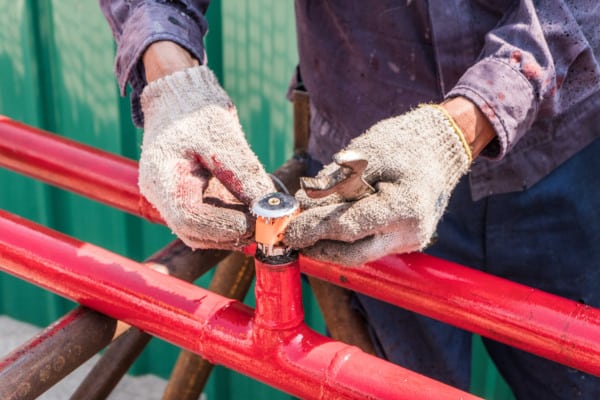Redesigned for the needs of sprinkler system installers, this overhauled standard improves readability, adds guidelines for residential sprinklers
NFPA 13: Standard for the Installation of Sprinkler Systems has provided guidance to sprinkler system installers for more than a century. The standard has grown in scope and scale over the course of more than 60 editions that address everything from technological innovations to best practices for system design.
Most significant changes to the 2019 edition of NFPA 13 are part of a major effort to make this wide-ranging document more accessible. In the first installment of our two-part series, we’ll look at how NFPA 13 has been reorganized and the tools available to help you locate information in the new standard. We’ll also begin looking at the technical revisions to the 2019 edition, starting with new and altered sections pertaining to the use of residential sprinkler heads.
If you’d like, you can click here to browse our selection of commercial and residential fire sprinkler heads and system components instead.
The 2019 edition of NFPA 13 follows a designer-friendly sequence and sorts out the “junk drawer” of installation requirements
After defining key terms and introducing general requirements, NFPA 13 begins where designers of fire sprinkler systems begin: with the water supply and piping. The standard continues with system types and sprinkler placement before considering installation requirements for sprinkler heads, valves, and piping. The standard rounds out with special requirements, working plans, and system acceptance requirements.
In previous editions, one of the largest sections was chapter 8, a catch-all or “junk drawer” chapter for installation requirements. But changes in the 2019 edition of NFPA 13 spread those installation requirements out across more than seven separate chapters. Most focus either on installation requirements for specific types of sprinklers or on the requirements for other system components.
The 2019 edition of NFPA 13 also reorganizes the requirements for storage sprinklers. The previous version addressed storage sprinklers over the course of ten chapters focused on the type of material stored and the method used to store it. The new edition tackles these requirements in only six chapters ordered largely by sprinkler type.
Readers can discover the 2019 edition’s changes for themselves using NFPA 13’s roadmap and annotated text
One change to the 2019 edition of NFPA 13 involves a new series of tables, called “the 2016-2019 Roadmap,” which are designed to make the transition between editions easier. This 26-page section, located just after the index (or page 544 in the PDF edition), pairs the old 2016 edition section number with the new 2019 section number. It also indicates when a section has been merged, deleted, or spread across multiple chapters.
This roadmap lists each section from the 2016 edition in sequence, allowing readers to find that section’s new number in the 2019 edition. For example, those looking to view the requirements for the use of listed fire sprinkler control valves – formerly located in section 6.6.1.3 – will find them in section 16.9.3.2 of the 2019 edition.

The 2019 edition also shades revised text and marks new additions with the letter “N.” For instance, the requirement for listings of fire sprinkler system components and hardware no longer mentions drain piping, drain valves, and signs as examples of unlisted equipment.

Instead, these examples have migrated to the annex for explanatory material, where a new section provides the NFPA’s reasoning for the requirement along with a few new examples.

The 2019 edition of NFPA 13 is better-aligned with residential standards on the use of piping and residential fire sprinkler placement
While another standard, NFPA 13R, focuses on residential buildings – including motels, apartment buildings, and some larger family homes – many multi-story residential buildings, nursing homes, and other large residential occupancies require fire sprinkler systems installed in accordance with NFPA 13. When building code considers two or more townhouses to constitute a single building, either standard may be used. And because NFPA 13 systems maximize property protection, some jurisdictions may elect to use NFPA 13 even when other standards would work.
Technical changes to the 2019 edition update the standards governing the installation of residential sprinklers in NFPA 13 systems. These changes expand the use of thermoplastic piping in some buildings and deal more thoroughly with the placement of residential sprinklers around beams and sloped surfaces. We’ll review each of these in turn in the following sections.
Section 16.3.9.6.2 allows installers to use thermoplastic piping in some residential garages
Previous editions of NFPA 13 allowed the use of chlorinated polyvinyl chloride (CPVC) pipe and other nonmetallic pipe only in rooms not exceeding 400 square feet in size. Some fire officials read these versions as requiring sprinkler contractors to use only metallic piping in garages – even if they use CPVC almost everywhere else. A change to the 2019 edition explicitly allows thermoplastic pipe in residential garages within some residential buildings covered by NFPA 13.
From the 2019 edition of NFPA 13
16.3.9.6.2 Where nonmetallic pipe installed in accordance with 16.3.9.6 supplies sprinklers in a private garage within a dwelling unit not exceeding 1000 ft2 (93 m2) in area, it shall be permitted to be protected from the garage compartment by not less than the same wall or ceiling sheathing that is required by the applicable building code.
While NFPA 13 classifies automobile parking and showrooms as Group 1 Ordinary Hazard, NFPA 13R specifically exempts private garages from the standards of ordinary hazard occupancies. This revision brings NFPA 13 into accord with NFPA 13R and the International Building Code, treating those garages as part of the dwelling unit and not as a separate occupancy subject to stricter standards.
Installers may place residential fire sprinklers near beams, and under beamed and sloped surfaces, in accordance with section 12.1.1 and 12.1.8.1
Since 2010, the NFPA’s research has recognized the need for design requirements specific to residential sprinklers placed in rooms with beams or sloped ceilings. Their experiments, discussed in the 2010 white paper “Analysis of the Performance of Residential Sprinkler Systems with Sloped or Sloped and Beamed Ceilings,” show that listed, properly-placed residential sprinkler heads can effectively fight fires in these environments.
The 2019 edition of NFPA 13 responds to this research, allowing installers to place some residential fire sprinklers under or adjacent to beams and sloped surfaces.
From the 2019 edition of NFPA 13
12.1.8.1.1 Pendent and upright sprinklers installed under beamed or beamed and sloped ceilings shall be permitted to be installed where all of the following apply:
(1) Maximum beam depth of 14 in. (350 mm)
(2) Maximum ceiling height of 24 ft (7.3 m)
(3) Maximum ceiling slope of 8 in 12
(4) Maximum compartment size of 600 ft2 (56 m2)12.1.8.1.2 Pendent-type residential sprinklers located under or adjacent to beams shall be installed in accordance with one of the following:
(1) Pendent, recessed pendent, and flush-type pendent sprinklers shall be permitted to be installed directly under a beam having a maximum depth of 14 in. (350 mm) with the sprinkler deflector 1 in. to 2 in. (25 mm to 50 mm) below the beam, or in accordance with the manufacturer’s instructions for recessed or flush sprinklers if the deflector is less than 1 in. (25 mm) below the beam, as shown in Figure 12.1.8.1.2(a).
(2) Pendent sprinklers shall be permitted to be installed adjacent to beams where the vertical centerline of the sprinkler is no greater than 2 in. (50 mm) from the edge of the beam and with the sprinkler deflector 1 in. to 2 in. (25 mm to 50 mm) below the beam, or in accordance with the manufacturer’s instructions for flush sprinklers if the deflector is less than 1 in. (25 mm) below the beam, as shown in Figure 12.1.8.1.2(b).
The new edition also clarifies that the previous section does not apply to concealed sprinklers, which must be placed according to more strict guidelines:
From the 2019 edition of NFPA 13
12.1.8.1.3 Concealed sprinklers shall be permitted to be installed in beams not greater than 4 in. (100 mm) in depth.

One other new addition – section 12.1.1 – brings NFPA 13’s chapter on installation requirements for residential sprinklers into alignment with existing residential fire code. 12.1.1 simply transplants sprinkler design criteria from NFPA 13R, which provides basic requirements for residential sprinklers by ceiling and sprinkler type.
To be continued: Significant Changes to the 2019 Edition of NFPA 13
This concludes part one of our look at the major changes to the 2019 edition of NFPA 13. In the next installment, we’ll look at technical changes impacting storage sprinklers, dry-pipe sprinkler systems, control valves, and other components.
For sprinkler designers, installers, and stakeholders, NFPA 13 offers some helpful changes in both style and substance with the 2019 edition. Let QRFS keep you informed and up-to-code – like us on Facebook at Facebook.com/QuickResponseFireSupply or follow us on Twitter @QuickResponseFS.
You can also click here to browse our selection of commercial and residential fire sprinkler heads and system components. We welcome any questions you might have: call us at +1 (888) 361-6662 or email support@qrfs.com.
This article was originally posted at blog.qrfs.com.



I am seeking information on the adoption of IBC Section 903.2.9 in california. This modifies the requirement for sprinklers substantially.
Michael — the sprinkler requirements for Group S-1 storage facilities are fairly complex. What information are you seeking about its adoption, exactly? Thanks for reading.
Are explanation joints required under NFPA 13 or 13R 13D 2019 for CPVC? or is it a consideration not code?
Chris — We assume you mean “expansion joints.” NFPA 13 treats expansion joints and similar measures as necessary in relation to seismic design (earthquake proofing) in chapter 18. We aren’t immediately aware of requirements of this nature related to CPVC, though that may be a strategy used to handle thermal expansion. Here is a good article on that topic.